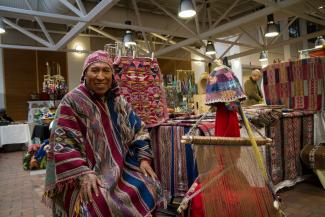
Timoteo Ccarita is an Andean textile artist from the community of Pitumarca, Peru. “Textile art dates back to the pre-Inca period in the district of Pitumarca,” Ccarita says. “It has never been considered an art, but rather a means of communication through iconography.” At the Cultural Survival Bazaars, he showcases traditional Andean textiles and tapestries.
Traditional Andean textiles embed iconographies and interpretations of the Andean cosmovision, observation of the stars, traditions and customs related to rituals and energetic synchronization of spirits, apu (mountains), pachamama (Mother Cosmos), teqsy muyo (Mother Earth), auquis (spirits), qhaha (energies), volcanoes, the sun, earthquakes, wind, and vibrations. “The traditional weavings in Pitumarca have maintained original designs and symbolism for thousands of years. Symbols are profound mysteries embodied ethnographically in each ancestral textile, transmitted from mother to daughter,” Ccarita says.
Ccarita’s path has not been an easy one. After he was abandoned by his father, his mother became blind and out of necessity taught him the art of weaving. “After the death of my mother, when I was 15, I used this art as a means of survival. During the ‘70s my community was abandoning the traditional handmade process because of the introduction of industrial yarn and synthetic dyes. I started working to keep traditional textile art alive, maintaining the original techniques in wool preparation, dyeing, and weaving of alpaca, vicuña, and sheep fibers.”
As Ccarita explains, traditional handmade processes take time. “First, the wool is sheared from the animal and hand spun into yarn with a spindle, which is suspended in the air and twirled until the yarn is strong enough to tolerate the strains of weaving. The weaver meticulously spins the wool until the yarn is impeccable and has become a fine, spongy ball. The wool is then dyed with natural dyes made from various plants, minerals, and even the juice from tiny squashed insects that produce a bright red color. The fiber of the alpaca is not dyed but left in its natural color, which is white, gray, or shades of brown and black, then woven into a heavier yet softer material that is much warmer for the wearer.
“Weaving llikllas (rectangular, handwoven shoulder cloth) or chalinas (shawls) is more tedious, requiring great skill, forethought, and mental calculations. Vertical and horizontal strands of yarn are carefully arranged by counting the correct number of threads, which are meticulously integrated into the fabric with a llama bone. The interface between the vertical and horizontal threads produce the desired width of bands of subtle reds, yellows, or blues. The lliklla’s plain color bands are interspersed with vertical bands of intricate, multicolored geometric Quechua iconography. Chullos (hats) and chuspas (bags) are hand-knitted. The same handmade threads are used, but they are softer and less twisted than the other threads.”
Ccarita has trained weavers in Ccapacchapi and has founded 19 weavers’ associations in several communities, improving the quality of life of poor communities in the Andes. “Nowadays,” he says, “I teach the weavers how to weave, and I also weave. I dye yarn and oversee the spinning of the wool. I prepare the warp and woof of the threads in the looms before weavers starts weaving. I oversee the progression of each piece until the finish. In Pitumarca, we work together to organize ourselves better, with more than 132 weavers throughout different communities.”
According to Ccarita, artists in Peru are discriminated against because of the way they dress and for using Indigenous languages. “We don’t have the technology required to spread and promote our knowledge. Big companies, industries, merchants, and designers receive more support than the true artisans who are always marginalized because they are traditionalists. They want us to adapt to their concept of fashion and the market, rather than promoting our traditional culture. They want us to produce or design as a fast fashion company. Big companies and fashion designers copy our traditional designs without any economic compensation to us.” This is especially problematic, he says, because “textiles are more than our main economic activity. It is our means of communication of our cultural identities. We see our textiles as an opportunity to fight against poverty and discrimination and to keep our cultures alive.”
Join us at this winter's Cultural Survival Bazaars:
December 15–16: Cambridge Rindge & Latin School, Cambridge, MA
December 21–23: Prudential Center, Boston, MA
Visit bazaar.cs.org and facebook.com/culturalsurvivalbazaars for more info.
